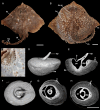Cellular, bone-like tissue in the bucklers and thorns of the thornback ray Raja clavata (Batoidea, Chondrichthyes)
- PMID: 40897316
- PMCID: PMC12404806
- DOI: 10.1098/rspb.2025.0489
Cellular, bone-like tissue in the bucklers and thorns of the thornback ray Raja clavata (Batoidea, Chondrichthyes)
Abstract
Chondrichthyans (cartilaginous fishes) have lost the cellular bone characteristic of other jawed vertebrate skeletons. However, we identify cellular bone-like tissue in modified scales with enlarged bases, called 'bucklers' and 'thorns', which are distinctive for one group of extant batoids (rays). As placoid scales, they possess spines of orthodentine and osteodentine, but a unique basal structure. This consists of a cell-rich material, previously misidentified as an acellular tissue. Newly formed basal tissue grows appositionally and episodically from a cell-rich periosteum-like layer and closely resembles cellular bone, with entombed cells situated between bundles of attachment fibres anchoring the scale to the underlying dermal tissue and the 'periosteum' to the scale surface. In histologically more mature tissue, the cell spaces and attachment fibres are remodelled, forming enlarged, elongated spaces. The result is a unique mineralized tissue in these rays, initially sharing similarities with cellular bone, but with a mature state where cell spaces are modified throughout the base, by proposed remodelling of the matrix. Our findings of cellular bone forming the attachment tissues in ray scales demonstrate the chondrichthyan capacity to deposit bone-like tissues within the odontode module, contrary to previous understandings of hard tissue evolution in vertebrates.
Keywords: Batoidea; Chondrichthyes; Raja clavata; bone; bucklers; placoid scales; skin denticles; thorns.
Conflict of interest statement
We declare a competing interest. The lead author was an associate editor for Proceedings B at the time of submission of this article.
Figures






Similar articles
-
Prescription of Controlled Substances: Benefits and Risks.2025 Jul 6. In: StatPearls [Internet]. Treasure Island (FL): StatPearls Publishing; 2025 Jan–. 2025 Jul 6. In: StatPearls [Internet]. Treasure Island (FL): StatPearls Publishing; 2025 Jan–. PMID: 30726003 Free Books & Documents.
-
Short-Term Memory Impairment.2024 Jun 8. In: StatPearls [Internet]. Treasure Island (FL): StatPearls Publishing; 2025 Jan–. 2024 Jun 8. In: StatPearls [Internet]. Treasure Island (FL): StatPearls Publishing; 2025 Jan–. PMID: 31424720 Free Books & Documents.
-
Growth and mechanical correlations of calcified cartilage in Batoidea: A histomorphological study using the Raja asterias model.J Fish Biol. 2025 Jul;107(1):23-33. doi: 10.1111/jfb.16037. Epub 2025 Jan 2. J Fish Biol. 2025. PMID: 39746859 Free PMC article.
-
Guided tissue regeneration for periodontal infra-bony defects.Cochrane Database Syst Rev. 2006 Apr 19;(2):CD001724. doi: 10.1002/14651858.CD001724.pub2. Cochrane Database Syst Rev. 2006. Update in: Cochrane Database Syst Rev. 2019 May 29;5:CD001724. doi: 10.1002/14651858.CD001724.pub3. PMID: 16625546 Updated.
-
The quantity, quality and findings of network meta-analyses evaluating the effectiveness of GLP-1 RAs for weight loss: a scoping review.Health Technol Assess. 2025 Jun 25:1-73. doi: 10.3310/SKHT8119. Online ahead of print. Health Technol Assess. 2025. PMID: 40580049 Free PMC article.
References
-
- Reif W. 1974. Morphogenese und Musterbildung des Hautzähnchen‐Skelettes von Heterodontus. Lethaia 7, 25–42. ( 10.1111/j.1502-3931.1974.tb00882.x) - DOI
-
- Reif WE. 1978. Protective and hydrodynamic function of the dermal skeleton of elasmobranchs. Neues Jahr. Geol. Paläontol. Abhand. Paleoecol. 157, 133–141.
-
- Reif WE. 1985. Squamation and ecology of sharks. Cour Forsch. Senckenberg 78, 1–255.
MeSH terms
LinkOut - more resources
Full Text Sources
Research Materials

